The latter years of the fourteenth-century and the early years of the fifteenth were the grimmest period in French history. Between the Black Death, the everlasting war with England, plundering raids, taxies and levies; circumstances conspired to reduce the voice of the people to one agonizing wail of pain. However, while France agonized, the rich collected. The example was set by King John II and his sons. When they died, exhausted by perhaps history’s most extravagant spending binge, they left behind collections that were in thmeselves works of art.
Jean, Duc de Berry was a self-confident connoisseur with a taste for the exquisite, an art collector with an insatiable appetite, Jean Duc de Berry , has had few peers as a patron of the arts. Indeed, his patronage was so extensive that he left his personal mark on the art of his age. The elegant decorative style known as the International Style was to a great extent fostered by de Berry in his role as director and monopolizer of whole teams of fine artists.
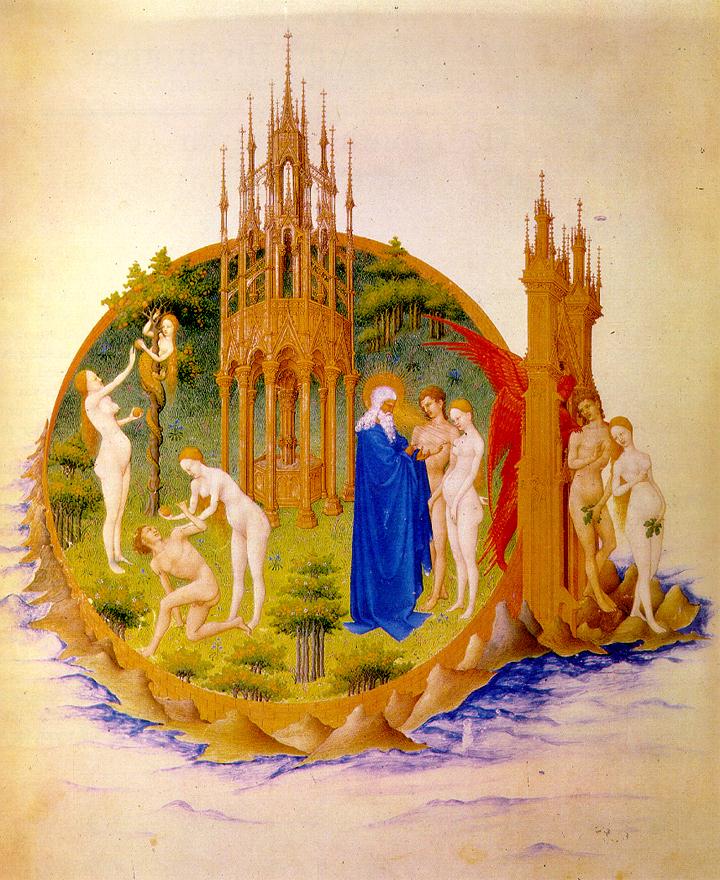
The Garden of Eden is an exquisite toy world , and Adam and Eve are refined and winsome, in the Limbourgs' rendering of the Fall for the Duc de Berry
The nineteenth-century French poets who celebrated decadent aestheticism and self-indulgent dandyhood might well have harked back to de Berry as their model. Here was an extravagant aristocrat who, among other conceits , kept live bears in his retinue when he travelled between his seventeen houses and who once kept a young girl captive in one of his castles to oblige an artist who was in love with her. To pay for his munificence , de Berry so oppressed the province of Languedoc that Charles VI had to take it away from him for the sake of civil peace.
”Paul ( Limbourg ) especially was on good terms with the duke, and received a court position as valet de chambre or personal attendant (his uncle had had the same position with the Duke of Burgundy). The duke gave him jewelry and a big house in Bourges. Paul was attracted to a young girl, Gillette la Mercière, but her parents disapproved. The duke had the girl confined, and released her only on the king’s command. In 1411 Paul and Gillette married anyway, but the marriage remained childless (the girl was 12, her husband 24 at the time).”
Yet it is not with decadence but with artistic renewal that de Berry’s name is deservedly associated. The brothers Limbourg, who illuminated for him a Book of Hours the ”Tres Riches Heures” , were gthe first to effectively incorporate into northern European art the concept of perspective. The ”Tres Riches Heures” of the Duc de Berry marked a turning point in the history of painting, and is possibly the most valuable book in the world today.
Satan spews up the damned with his fiery breath while demons work the realistic bellows of an infernal forge in the Limbourg's picture of Hell in the Tres Riches Heures. Evidently an influence on Bosch and the strange juxtapositions he created.
The Royal Gold Cup of the kings of England and France , shown above, is one of the few surviving relics of the Duc de Berry’s golden treasure trove. Studded with pearls, it is decorated with a translucent enamel painting that depicts the life of Saint Agnes, who was burned at the stake around A.D. 305. Because Saint Agnes was Charles V’s patron saint, he up is believed to have been originally from him. In 1434 the Duke of Bedford seized it as war booty, and his nephew Henry IV later inherited it.
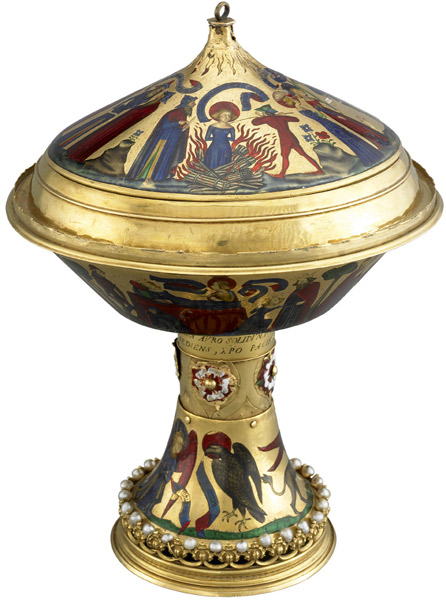
The Royal Gold Cup of the kings f England and France.''Agnes was imprisoned in a brothel as punishment for refusing to marry Procopius, son of the prefect Sempronius, in the time of the Emperor Constantine (reigned AD 306-337). She subsequently restored Procopius to life when he was strangled by a demon. Although he was repentant, Agnes was not spared her fate, and was condemned to burn. However, the flames had no effect on her, and she had to be killed with a spear. The cover of the cup is devoted to this section of the story, with each scene explained by a Latin inscription.'' British Museum
When the cup passed through the hands of England’s tudor kings, its stem was adorned with the Tudor rose emblem, one reason, perhaps, why the first Stuart king, James I, gave it away to a Spaniard soon after his accession. In 1892 the British Museum acquired it from a French family, by which time the much traveled and much ornamented cup had lost several of its precious sapphires, rubies and pearls.
As a patron of the arts, Louis, Duke of Anjou , lagged behind his brothers. If the new courtly art they favored tended at times toward ostentation, this defect was strongest in Louis’s patronage. it is not his
ection of more than three thousand gold and silver objects but his ownership of silver kitchenware that reveals his rule of taste. And this taste seem determined by his mouth and stomach. The rule in general, was that any object that could be made in a precious metal should be, and any surface that could be decorated should be laden with ornament.
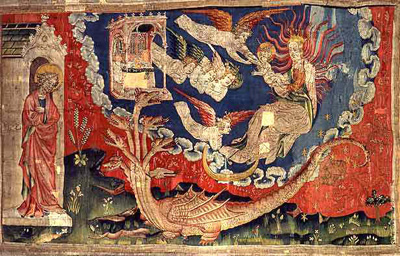
''These 76 tapestries are the oldest in the known world. There are 8 missing, but tapestry scholars through the centuries have been able to piece it all together. Actually, given the destructive history of the castle from the feudal wars to the French Revolution to the Nazis blowing up a munitions warehouse outside the castle walls, it’s amazing to see how well preserved they are.''
Whereas his brothers had their books illustrated with superb miniatures, Louis had decorations adorning his eating utensils, which were usually of gold. None of the Duke,s golden tableware survives, partly because of Louis himself. it is recorded that one of his goldsmiths became a hermit after the Duke melted down all his creations to raise funds. Still the Duke of Anjou can claim a peerless distinction as an art patron in that he commissioned one of the masterpieces of medieval art. This is a sequence of huge tapestries illustrating in some ninety scenes the Book of Revelation, or the Apocalypse, the last book of the New Testament. The Angers tapestries are the oldest, the largest, and perhaps the finest examples of this type of weaving to survive.
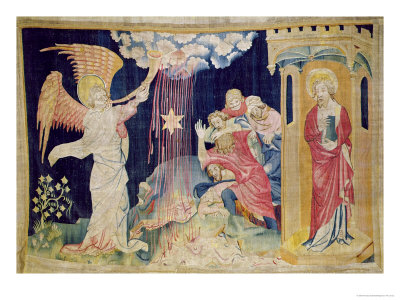
''And the third angel sounded, and there fell a great star from heaven... And the name of the star is called 'Wormwood' ''
In his unabashed love of opulent display, Philip the Bold, Duke of Burgundy, not only outmatched his brothers but initiated a tradition that long made the Burgundian court a byword for extravagance. One source of that extravagance was a literary ideal, for Philip was guided by those tales of chivalry and conventions of knightly romance to which all the Valois brothers were devoted. In a sense, they were bent on creating a mode of courtly life that had never existed except in the ballads of the troubadours and the tales of the romancers, but they took it seriously nonetheless.
Perhaps this is one reason why Philip and his brothers were such extraordinarily munificent patrons of the arts. They urgently needed the vast tapestries , the ornate jewelry, gold utensils, luxurious clothing, illuminated prayer books, and elaborate castles in order to create that environment of elegance that was inseparable from the fantasies of chivalry they were trying to bring to life.
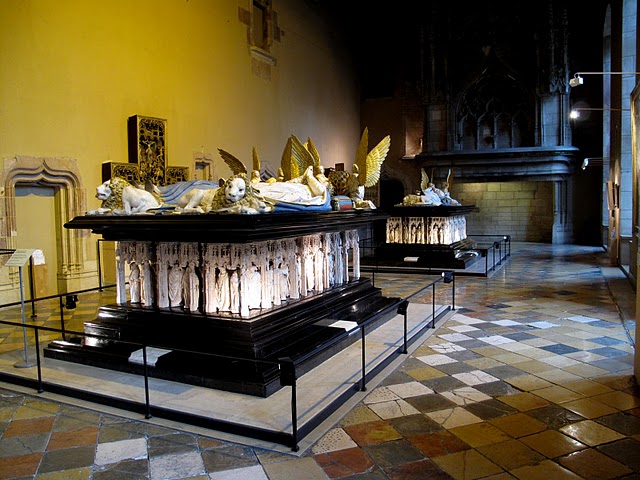
Tomb of Philip the Bold. ''During the 14th and 15th centuries, the Valois dukes of Burgundy were among the most powerful rulers in the Western world, presiding over vast territories in present-day France, Luxembourg, Belgium and the Netherlands from their capital in Dijon. The significant artistic patronage of the dukes drew artists, musicians and writers to Dijon, which became a major center of creativity and artistic patronage.'' ( Sean Martinfield
Interestingly, however, it was through the far more traditional motive of religious piety that philip the Bold is best remembered in the history of art. When he commissioned his resident artist, Claus Sluter, to design a lavish tomb and erest a huge ornamented crucifix, for a Carthusian monastery, he gave the gifted Dutch artist an unparalleled opportunity to create two masterpieces of fourteenth century sculpture. In the end no patron can do more than that.
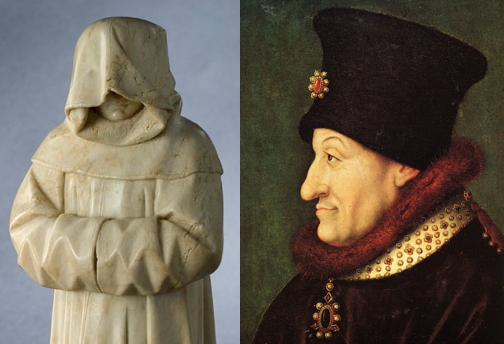
Mourner and Philip the Bold.''This prolific creativity and innovation extended to the ducal court’s sculpture workshop, which produced some of the most significant art of the period. The tombs of the first two Burgundian dukes, John the Fearless and his father Philip the Bold, are among the best examples. ''
”The outlandish number of miniatures and portraits in one Book of Hours in particular had an influence on the entire history of illumination. In the 1330s, Blanche of Burgundy, countess of Savoy and granddaughter of King (later Saint) Louis IX, commissioned an unprecedented Book of Hours. It had more than two hundred miniatures incorporating about eighty portraits of Blanche! King Charles V, who owned the Savoy Hours in the 1370s, himself added an extra sixty-eight miniatures, nearly half of which included portraits of him. Charles’s brother Jean, duc de Berry, was so envious of his brother’s Book of Hours that he commissioned his own, the so-called Petites Heures, whose texts, picture cycles, and use of portraiture closely mimic those of the book he was unable to possess. Thus began Jean’s career for commissioning increasingly lavish Books of Hours, in all of which portraiture plays a key role. (The Petites Heures is today in Paris, Bibliothèque Nationale de France, MS lat. 18014. The Savoy Hours was destroyed in the 1904 fire at the Biblioteca Nazionale in Turin, MS E.V.49; however, twenty-six leaves, which had been detached from the book before the conflagration, are today in New Haven, Yale University, Beinecke MS 390.)”








 COMMENTS
COMMENTS



